TOYOTA CAMRY 2018 Owners Manual (in English)
Manufacturer: TOYOTA, Model Year: 2018, Model line: CAMRY, Model: TOYOTA CAMRY 2018Pages: 612, PDF Size: 10.63 MB
Page 311 of 612
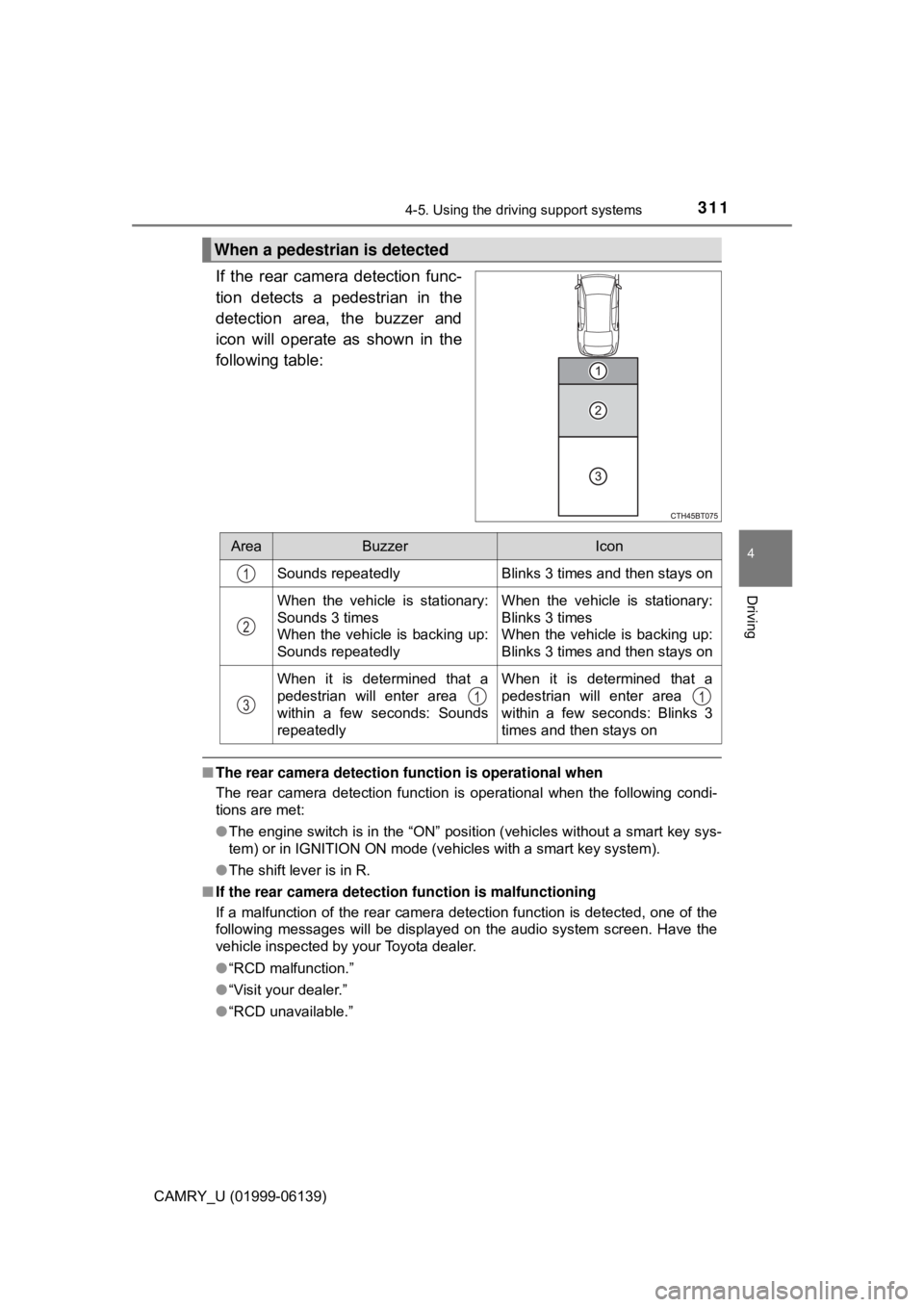
3114-5. Using the driving support systems
4
Driving
CAMRY_U (01999-06139)
If the rear camera detection func-
tion detects a pedestrian in the
detection area, the buzzer and
icon will operate as shown in the
following table:
■ The rear camera detection function is operational when
The rear camera detection function is operational when the following condi-
tions are met:
●The engine switch is in the “ON” position (vehicles without a smart key sys-
tem) or in IGNITION ON mode (vehicles with a smart key system).
● The shift lever is in R.
■ If the rear camera detection function is malfunctioning
If a malfunction of the rear camera detection function is detected, one of the
following messages will be displayed on the audio system screen. Have the
vehicle inspected by your Toyota dealer.
● “RCD malfunction.”
● “Visit your dealer.”
● “RCD unavailable.”
When a pedestrian is detected
AreaBuzzerIcon
Sounds repeatedlyBlinks 3 times and then stays on
When the vehicle is stationary:
Sounds 3 times
When the vehicle is backing up:
Sounds repeatedlyWhen the vehicle is stationary:
Blinks 3 times
When the vehicle is backing up:
Blinks 3 times and then stays on
When it is determined that a
pedestrian will enter area
within a few seconds: Sounds
repeatedlyWhen it is determined that a
pedestrian will enter area
within a few seconds: Blinks 3
times and then stays on
1
2
311
Page 312 of 612

3124-5. Using the driving support systems
CAMRY_U (01999-06139)■
Situations in which the system may not operate properly
●Some pedestrians, such as the following, may not be detected by the Rear
Camera Detection function, preventing the function from operating properly:
• Pedestrians who are squatting
• Pedestrians who are lying down
• Pedestrians who are running
• Pedestrians who suddenly enter the detection area
• Pedestrians riding a bicycle, skateboard, or other light vehicle
• Pedestrians wearing unusual clothing, such as a costume
• Pedestrians whose body is partially hidden by a cart or other object
• Pedestrians which are obscured by darkness, such as at night
● In some situations, such as the following, pedestrians may not be detected
by the Rear Camera Detection function, preventing the function from operat-
ing properly:
• When backing up in inclement weather (rain, snow, fog, etc.)
• When the rear camera is obscured (dirt, snow, ice, etc. are attached) or
scratched
• When a very bright light, such as the sun, or the headlights of another vehicle, shines directly into the rear camera
• When backing up in a place where the surrounding brightness changes suddenly, such as at the entrance or exit of a garage or underground
parking lot
● In some situations, such as the following, the Rear Camera Detection func-
tion may operate even though there are no pedestrians in the detection
area.
• When a three dimensional object, such as a pole, traffic cone, fence, or
parked vehicle, is detected
• When a moving object, such as a car or motorcycle is detected
• When backing up toward moving objects such as flags or puddles, or air- borne matter, such as smoke, steam, rain, or snow
• When there is a pattern on the road, due to the road being made of cob-
blestone or gravel or having tram rails, traces of repair, white lines,
pedestrian crossings or fallen leaves on the surface
• When backing up on a metal cover (grating), such as those used for
drainage ditches
• When backing up toward the roadside or a bump in the road
• When an object is reflected in a puddle or on a wet road surface
• When there are shadows on the road
• When backing up over a bump in the road
• If the vehicle is significantly tilted, such as when carrying a heavy load
• When backing up toward an incline/decline
• If the suspension has been modified or tires of a size other than specified are installed
• If the rear of the vehicle is raised or lowered due to the carried load
• If an electronic component, such as a backlit license plate (especially flu- orescent type), is installed near the rear camera
• If a bumper protector, such as an additional trim strip, is installed to the rear bumper
Page 313 of 612

3134-5. Using the driving support systems
4
Driving
CAMRY_U (01999-06139)• If the orientation of the rear camera has been changed due to a collision
or other impact, or removal and installation
• If a towing eyelet is installed to the rear of the vehicle
• When the rear camera is obscured (dirt, snow, ice, etc. are attached) or
scratched
• When water is flowing over the rear camera lens
• If there is a flashing light in the detection area, such as the emergency
flashers of another vehicle
■ Situations in which the Rear Camera Detection function may be difficult
to notice
●If buzzer may be difficult to hear if the surrounding area is noisy, the volume
of the audio system volume is high, the air conditioning system is being
used, etc.
● If the temperature in the cabin is extremely high or low, the audio system
screen may not operate correctly.
Page 314 of 612
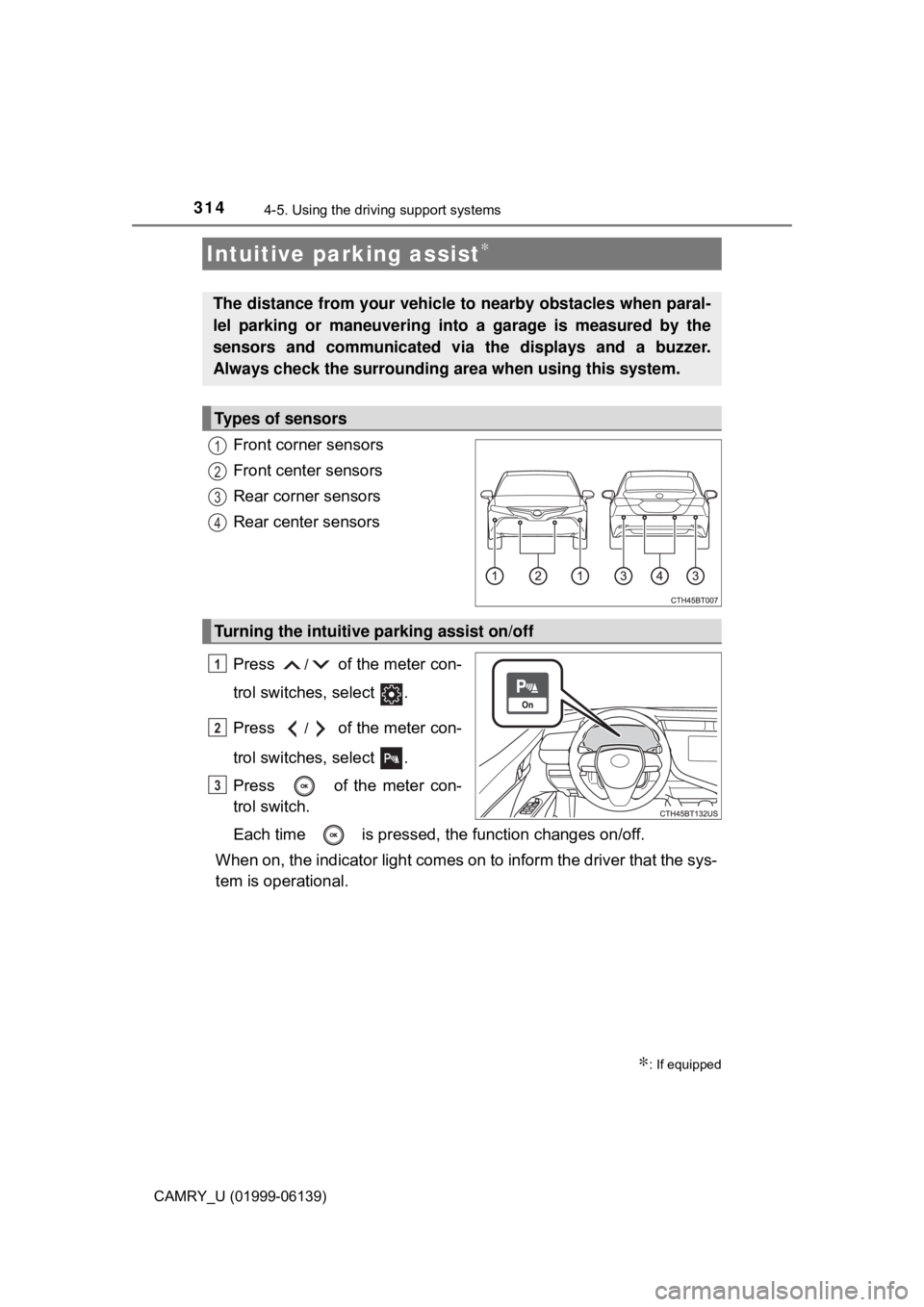
3144-5. Using the driving support systems
CAMRY_U (01999-06139)
Front corner sensors
Front center sensors
Rear corner sensors
Rear center sensors
Press
/ of the meter con-
trol switches, select .
Press
/ of the meter con-
trol switches, select .
Press of the meter con-
trol switch.
Each time is pressed, the function changes on/off.
When on, the indicator light comes on to inform the driver that the sys-
tem is operational.
Intuitive parking assist∗
∗: If equipped
The distance from your vehicle to nearby obstacles when paral-
lel parking or maneuvering into a garage is measured by the
sensors and communicated via the displays and a buzzer.
Always check the surrounding area when using this system.
Types of sensors
1
2
3
4
Turning the intuitive parking assist on/off
1
2
3
Page 315 of 612
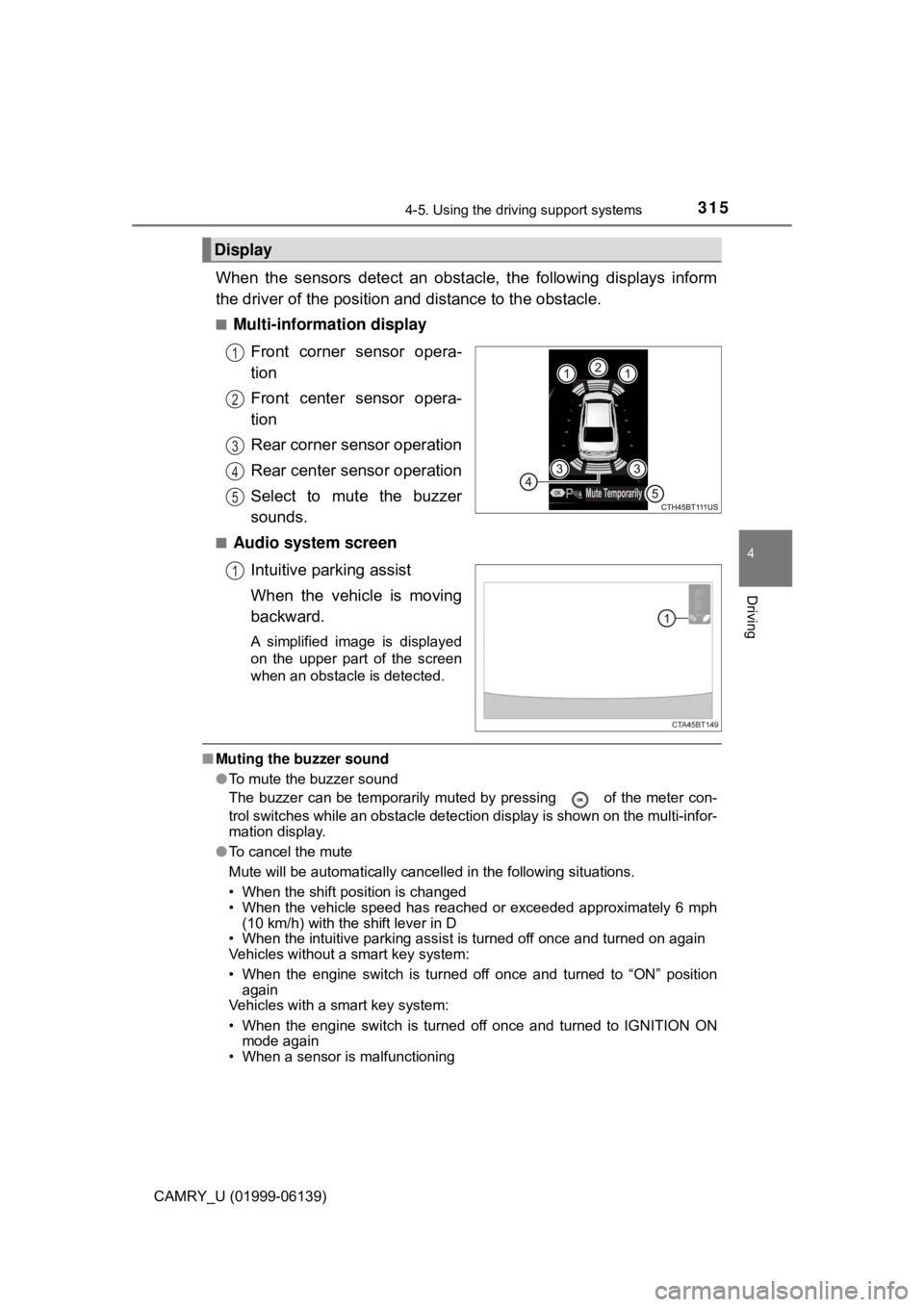
3154-5. Using the driving support systems
4
Driving
CAMRY_U (01999-06139)
When the sensors detect an obstacle, the following displays inform
the driver of the position an d distance to the obstacle.
■Multi-information display
Front corner sensor opera-
tion
Front center sensor opera-
tion
Rear corner sensor operation
Rear center sensor operation
Select to mute the buzzer
sounds.
■Audio system screenIntuitive parking assist
When the vehicle is moving
backward.
A simplified image is displayed
on the upper part of the screen
when an obstacle is detected.
■Muting the buzzer sound
●To mute the buzzer sound
The buzzer can be temporarily muted by pressing of the meter con-
trol switches while an obstacle detection display is shown on the multi-infor-
mation display.
● To cancel the mute
Mute will be automatically cancelled in the following situations.
• When the shift position is changed
• When the vehicle speed has reached or exceeded approximately 6 mph
(10 km/h) with the shift lever in D
• When the intuitive parking assist is turned off once and turned on again
Vehicles without a smart key system:
• When the engine switch is turned off once and turned to “ON” position again
Vehicles with a smart key system:
• When the engine switch is turned off once and turned to IGNITION ON
mode again
• When a sensor is malfunctioning
Display
1
2
3
4
5
1
Page 316 of 612
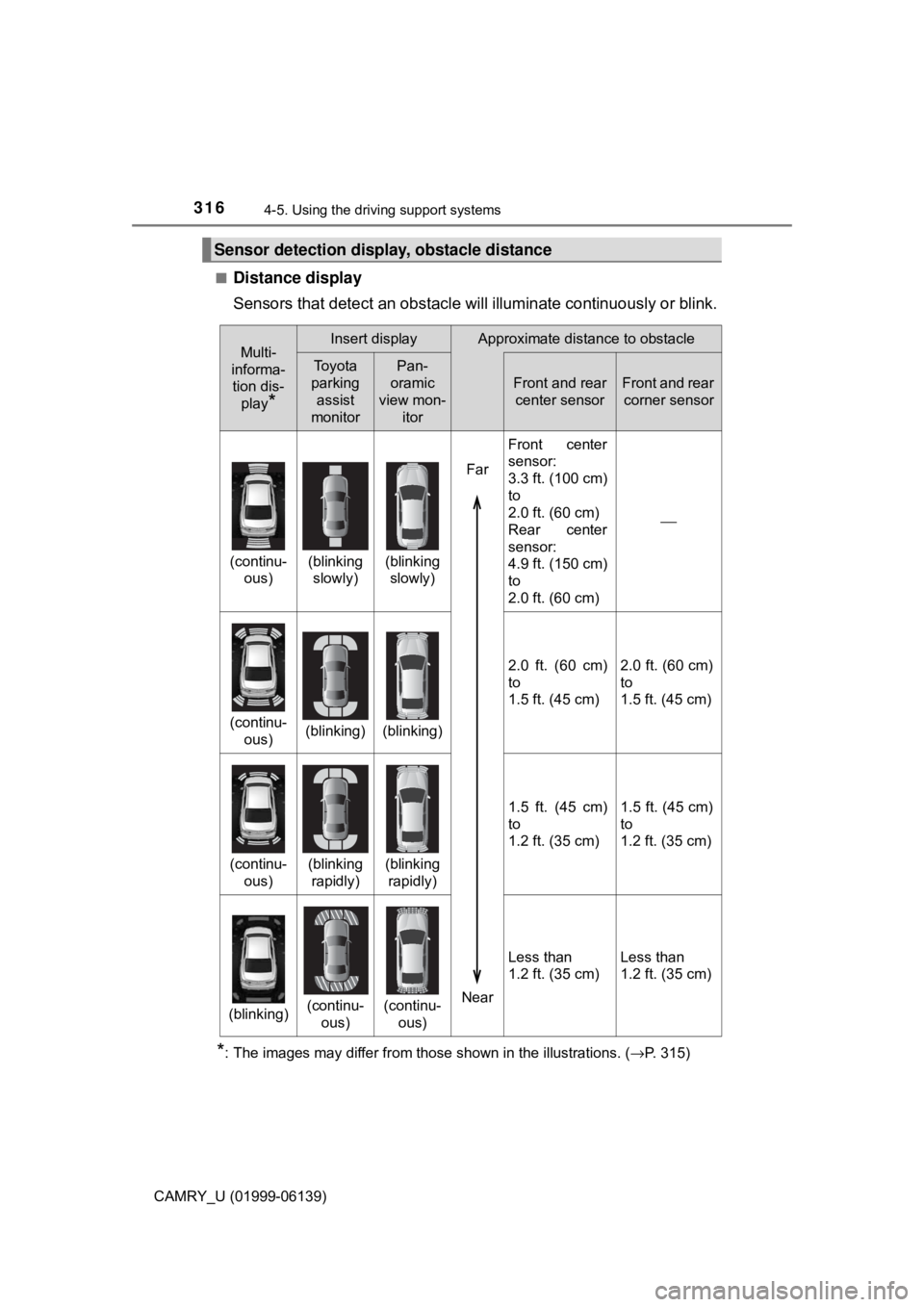
3164-5. Using the driving support systems
CAMRY_U (01999-06139)■
Distance display
Sensors that detect an
obstacle will illuminate continuously or blink.
*: The images may differ from those shown in the illustrations. ( →P. 315)
Sensor detection display, obstacle distance
Multi-
informa- tion dis-
play
*
Insert displayApproximate distance to obstacle
Toyota
parking assist
monitorPan-
oramic
view mon- itor
Front and rear center sensorFront and rear corner sensor
(continu- ous)(blinking slowly)(blinking slowly)
Far
Near Front center
sensor:
3.3 ft. (100 cm)
to
2.0 ft. (60 cm)
Rear center
sensor:
4.9 ft. (150 cm)
to
2.0 ft. (60 cm)
⎯
(continu-
ous)(blinking)(blinking) 2.0 ft. (60 cm)
to
1.5 ft. (45 cm)
2.0 ft. (60 cm)
to
1.5 ft. (45 cm)
(continu-
ous)(blinking rapidly)(blinking rapidly) 1.5 ft. (45 cm)
to
1.2 ft. (35 cm)
1.5 ft. (45 cm)
to
1.2 ft. (35 cm)
(blinking)(continu-
ous)(continu-ous) Less than
1.2 ft. (35 cm)
Less than
1.2 ft. (35 cm)
Page 317 of 612
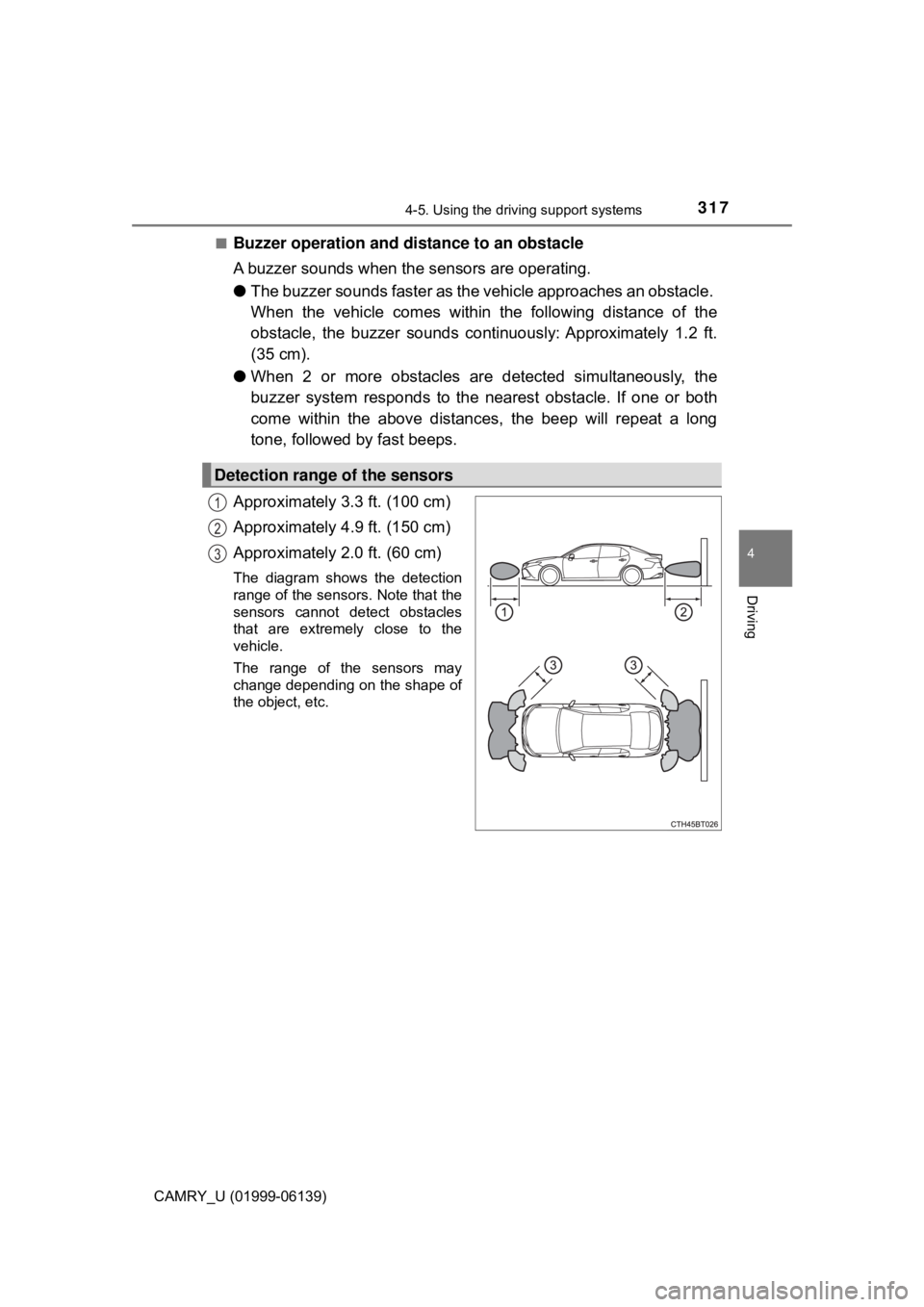
3174-5. Using the driving support systems
4
Driving
CAMRY_U (01999-06139)■
Buzzer operation and distance to an obstacle
A buzzer sounds when t
he sensors are operating.
● The buzzer sounds faster as the vehicle approac hes an obstacle.
When the vehicle comes within the following distance of the
obstacle, the buzzer sounds continuously: Approximately 1.2 ft.
(35 cm).
● When 2 or more obstacles ar e detected simultaneously, the
buzzer system responds to the nearest obstacle. If one or both
come within the above distanc es, the beep will repeat a long
tone, followed by fast beeps.
Approximately 3.3 ft. (100 cm)
Approximately 4.9 ft. (150 cm)
Approximately 2.0 ft. (60 cm)
The diagram shows the detection
range of the sensors. Note that the
sensors cannot detect obstacles
that are extremely close to the
vehicle.
The range of the sensors may
change depending on the shape of
the object, etc.
Detection range of the sensors
1
2
3
Page 318 of 612

3184-5. Using the driving support systems
CAMRY_U (01999-06139)
Vehicles without a smart key sy stem: The buzzer volume can be
changed on the multi-information display ( →P. 106) when the engine
switch is in the “ON” position.
Vehicles with a smart key syst em: The buzzer volume can be
changed on the multi-information display ( →P. 106) when the engine
switch is in the IGNITION ON mode.
■ The intuitive parking assist can be operated when
●Front corner sensors:
• Vehicles without a smart key system: The engine switch is in the “ON”
position.
• Vehicles with a smart key system: The engine switch is in IGNITION ON mode.
• The shift lever is in other than P.
• The vehicle speed is less than about 6 mph (10 km/h).
● Front center sensors:
• Vehicles without a smart key system: The engine switch is in the “ON”
position.
• Vehicles with a smart key system: The engine switch is in IGNITION ON mode.
• The shift lever is in other than P or R.
• The vehicle speed is less than about 6 mph (10 km/h).
● Rear corner and rear center sensors:
• Vehicles without a smart key system: The engine switch is in the “ON”
position.
• Vehicles with a smart key system: The engine switch is in IGNITION ON mode.
• The shift lever is in R.
• The vehicle speed is less than about 6 mph (10 km/h).
■ Intuitive parking assist display
When an obstacle is detected while the Toyota parking assist monitor or pan-
oramic view monitor is in use, the warning indicator will appear in the upper
part of the screen even if the display setting has been set to off.
Changing the buzzer sounds volume
Page 319 of 612
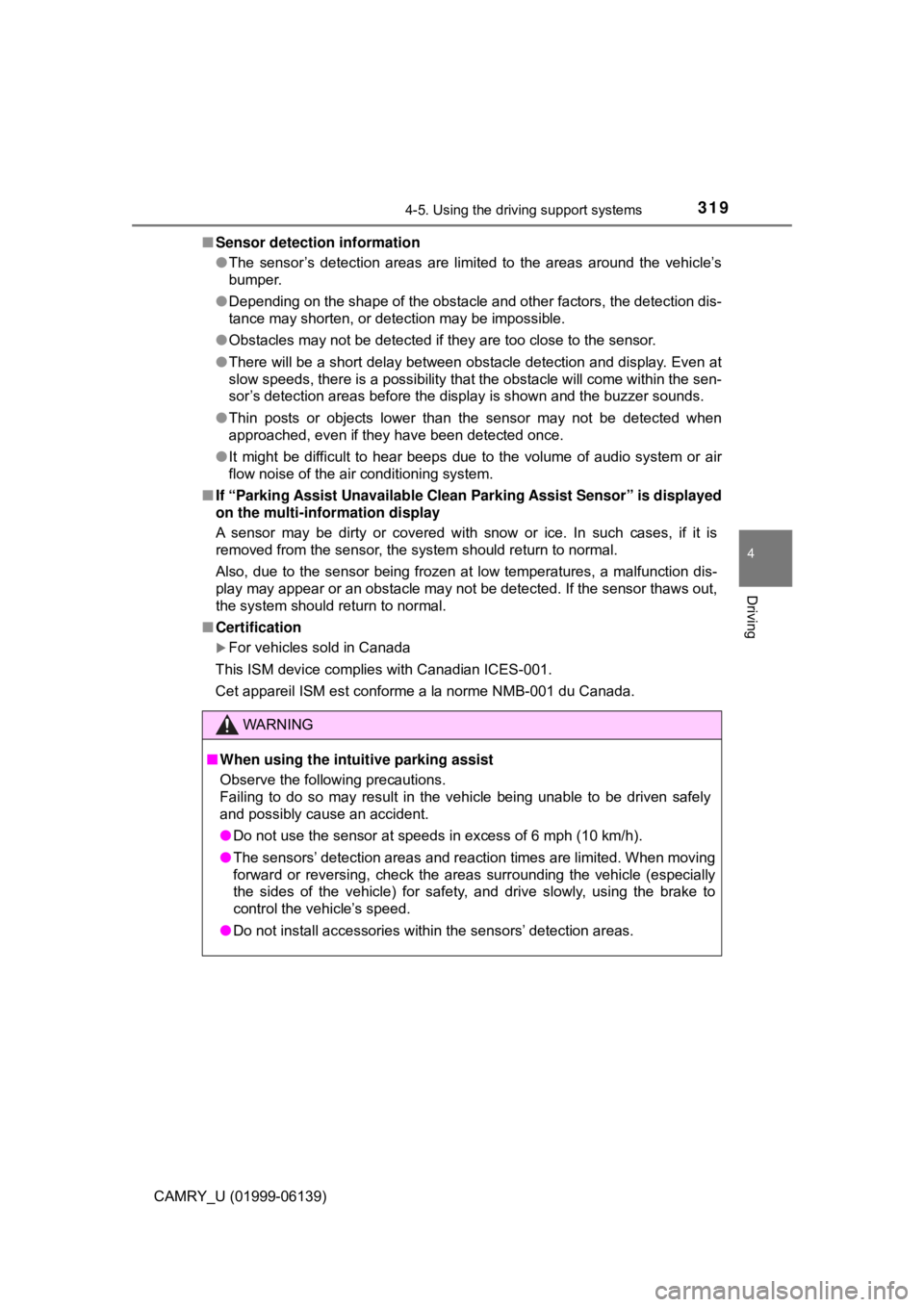
3194-5. Using the driving support systems
4
Driving
CAMRY_U (01999-06139)■
Sensor detection information
●The sensor’s detection areas are limited to the areas around the vehicle’s
bumper.
● Depending on the shape of the obstacle and other factors, the detection dis-
tance may shorten, or detection may be impossible.
● Obstacles may not be detected if they are too close to the sensor.
● There will be a short delay between obstacle detection and display. Even at
slow speeds, there is a possibility that the obstacle will come within the sen-
sor’s detection areas before the display is shown and the buzzer sounds.
● Thin posts or objects lower than the sensor may not be detected when
approached, even if they have been detected once.
● It might be difficult to hear beeps due to the volume of audio system or air
flow noise of the air conditioning system.
■ If “Parking Assist Unavailable Clean Parking Assist Sensor” is displayed
on the multi-information display
A sensor may be dirty or covered with snow or ice. In such cases, if it is
removed from the sensor, the system should return to normal.
Also, due to the sensor being frozen at low temperatures, a malfunction dis-
play may appear or an obstacle may not be detected. If the sensor thaws out,
the system should return to normal.
■ Certification
For vehicles sold in Canada
This ISM device complies with Canadian ICES-001.
Cet appareil ISM est conforme a la norme NMB-001 du Canada.
WARNING
■ When using the intuitive parking assist
Observe the following precautions.
Failing to do so may result in the vehicle being unable to be driven safely
and possibly cause an accident.
● Do not use the sensor at speeds in excess of 6 mph (10 km/h).
● The sensors’ detection areas and reaction times are limited. When moving
forward or reversing, check the areas surrounding the vehicle (especially
the sides of the vehicle) for safety, and drive slowly, using the brake to
control the vehicle’s speed.
● Do not install accessories within the sensors’ detection areas.
Page 320 of 612
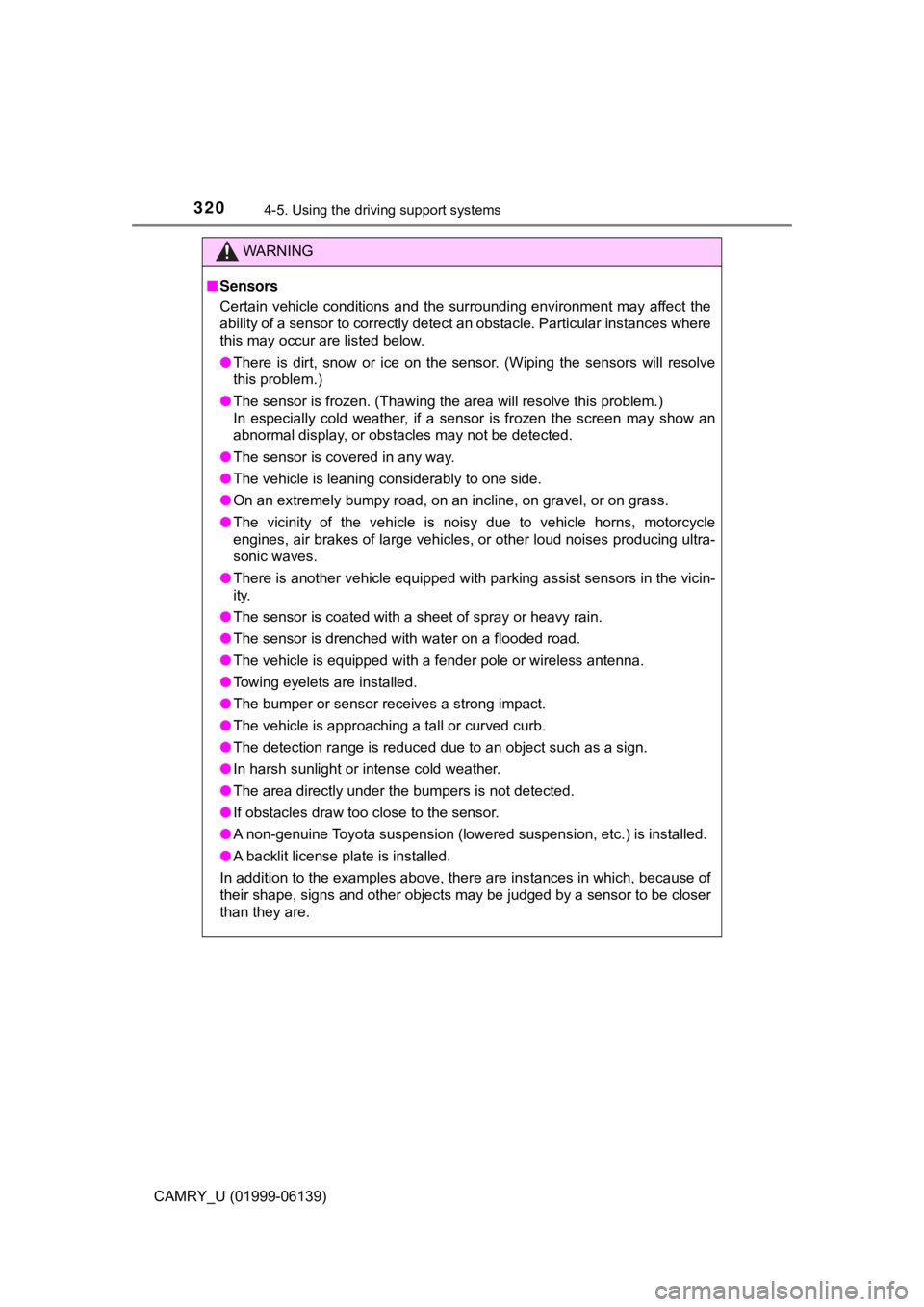
3204-5. Using the driving support systems
CAMRY_U (01999-06139)
WARNING
■Sensors
Certain vehicle conditions and the surrounding environment may affect the
ability of a sensor to correctly detect an obstacle. Particular instances where
this may occur are listed below.
● There is dirt, snow or ice on the sensor. (Wiping the sensors will resolve
this problem.)
● The sensor is frozen. (Thawing the area will resolve this problem.)
In especially cold weather, if a sensor is frozen the screen may show an
abnormal display, or obstacles may not be detected.
● The sensor is covered in any way.
● The vehicle is leaning considerably to one side.
● On an extremely bumpy road, on an incline, on gravel, or on grass.
● The vicinity of the vehicle is noisy due to vehicle horns, motorcycle
engines, air brakes of large vehicles , or other loud noises producing ultra-
sonic waves.
● There is another vehicle equipped with parking assist sensors in the vicin-
ity.
● The sensor is coated with a sheet of spray or heavy rain.
● The sensor is drenched with water on a flooded road.
● The vehicle is equipped with a fender pole or wireless antenna.
● Towing eyelets are installed.
● The bumper or sensor receives a strong impact.
● The vehicle is approaching a tall or curved curb.
● The detection range is reduced due to an object such as a sign.
● In harsh sunlight or intense cold weather.
● The area directly under the bumpers is not detected.
● If obstacles draw too close to the sensor.
● A non-genuine Toyota suspension (lowered suspension, etc.) is installed.
● A backlit license plate is installed.
In addition to the examples above, there are instances in which, because of
their shape, signs and other objects may be judged by a sensor to be closer
than they are.